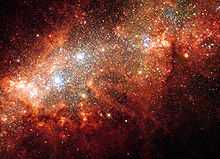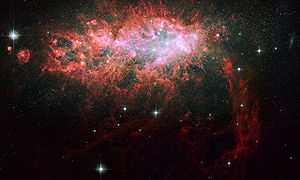NGC 1569
| NGC 1569 | |
|---|---|
|
| |
| Observation data (J2000 epoch) | |
| Constellation | Camelopardalis |
| Right ascension | 4h 30m 49.1s[1] |
| Declination | +64° 50′ 53″[1] |
| Redshift | -104 km/s[1] |
| Distance | 10.96 ± 0.65 Mly (3.36 ± 0.20 Mpc[2]) |
| Type | IBm[1] |
| Apparent dimensions (V) | 3′.6 × 1′.8[1] |
| Apparent magnitude (V) | 11.9[1] |
| Notable features | Contains two super star clusters |
| Other designations | |
| VII Zw 016,[1] Arp 210[1] | |
NGC 1569 is a dwarf irregular galaxy in Camelopardalis. While this faint galaxy is not a popular amateur astronomy target, it is well studied by professional astronomers, who are interested in the history of star formation within the galaxy. The galaxy is relatively nearby. Consequently, the Hubble Space Telescope can easily resolve the stars within the galaxy.[3] The distance to the galaxy was previously believed to be only 2.4 Mpc (7.8 Mly).[4] However, in 2008 scientists studying images from Hubble calculated the galaxy's distance at nearly 11 million light-years away, about 4 million light-years farther than previous thought and making it a member of the IC 342 group of galaxies.[2][5]
Physical characteristics
NGC 1569 is smaller than the Small Magellanic Cloud, but brighter than the latter or the Large Magellanic Cloud[6]
Starburst
The most notable feature of NGC 1569 is its powerful starburst. It has formed stars at a rate 100 times greater than that of our galaxy during the last 100 million years.[5] It contains two prominent super star clusters with different histories.[3][7] Both clusters have experienced episodic star formation. Super star cluster A, located in the northwest of the galaxy and actually formed of two close clusters (NGC 1569 A1 and NGC 1569 A2),[8] contains young stars (including Wolf-Rayet stars) that formed less than 5 million years ago (in NGC 1569 A1) as well as older red stars (in NGC 1569 A2).[7][9] Super star cluster B, located near the center of the galaxy, contains an older stellar population of red giants and red supergiants.[3][7][9] Both of these star clusters are thought to have masses equivalent to the masses of the globular clusters in the Milky Way (approximately (6-7) × 105 solar masses[2]). Numerous smaller star clusters, some of them having masses similar to those of small globular clusters or R136 in the Large Magellanic Cloud, with relatively young ages (between 2 million years and 1 billion years) have also been identified.[3] These results, along with the results from other dwarf galaxies such as the Large Magellanic Cloud and NGC 1705, demonstrate that star formation in dwarf galaxies does not occur continuously but instead occurs in a series of short, nearly instantaneous bursts.

The many supernovae produced in the galaxy as well as the strong stellar winds of its stars have produced filaments and bubbles of ionized hydrogen with respective sizes of up to 3,700 and 380 light years that shine excited by the light of the young stars contained within them and that are conspicuous on images taken with large telescopes.[5]
NGC 1569's starburst its believed to have been triggered by interactions with other galaxies of the IC 342 group, most notably a nearby cloud of neutral hydrogen.[5][10] More recent studies suggest the presence of tidal tails linking this galaxy with IC 342 and the dwarf galaxy UGCA 92 (see below) whose nature, however is unclear and may actually be structures within our galaxy[11]
Blueshift
NGC 1569 is exceptional in that its spectrum is blueshifted.[1] This means that the galaxy is moving towards the Earth. In contrast, the spectra of most other galaxies are redshifted because of the expansion of the universe.
Environment
The dwarf irregular galaxy UGCA 92 is often assumed to be a companion of NGC 1569; however, its relationship to the starburst the latter is experiencing is unclear, with some authors suggesting UGCA 92 has not started it[12] and others suggesting it has interacted with NGC 1569, being connected with it by a tidal tail and several filaments of neutral hydrogen; however, it is still unclear if those structures are associated with them or actually within the Milky Way, being unrelated with those two galaxies.[11]
References
- ↑ 1.0 1.1 1.2 1.3 1.4 1.5 1.6 1.7 1.8 1.9 1.10 "NASA/IPAC Extragalactic Database". Results for NGC 1569. Retrieved 2007-03-15.
- ↑ 2.0 2.1 2.2 Grocholski, Aaron J.; Aloisi, Alessandra; van der Marel, Roeland P.; Mack, Jennifer et al. (October 20, 2008). "A New Hubble Space Telescope Distance to NGC 1569: Starburst Properties and IC 342 Group Membership". Astrophysical Journal Letters 686 (2): L79–L82. arXiv:0808.0153. Bibcode:2008ApJ...686L..79G. doi:10.1086/592949.
- ↑ 3.0 3.1 3.2 3.3 D. A. Hunter; R. W. O'Connell; J. S. Gallagher; T. A. Smecker-Hane (2000). "The Star Clusters in the Starburst Irregular Galaxy NGC 1569". Astronomical Journal 120 (5): 2383–2401. arXiv:astro-ph/0009280. Bibcode:2000AJ....120.2383H. doi:10.1086/316810.
- ↑ Makarova, L. N.; Karachentsev, I. D. (2003). "On the Distance to Nearby Dwarf Galaxy NGC 1569". Astrophysics (English translation of Astrofizika) 46 (2): 144–150. Bibcode:2003Ap.....46..144M. doi:10.1023/A:1024055702766.
- ↑ 5.0 5.1 5.2 5.3 Hubble Resolves Puzzle about Loner Starburst Galaxy Newswise, Retrieved on November 17, 2008.
- ↑ Karachentsev, Igor D.; Karachentseva, Valentina E.; Huchtmeier, Walter K.; Makarov, Dmitry I. (2003). "A Catalog of Neighboring Galaxies". The Astronomical Journal 127 (4): 2031–2068. Bibcode:2004AJ....127.2031K. doi:10.1086/382905.
- ↑ 7.0 7.1 7.2 L. Origlia; C. Leitherer; A. Aloisi; L. Greggio et al. (2001). "The Stellar Content of the Super-Star Clusters in NGC 1569". Astronomical Journal 122 (2): 815–824. arXiv:astro-ph/0105195. Bibcode:2001AJ....122..815O. doi:10.1086/321152.
- ↑ G. de Marchi; M. Clampin; L. Greggio; C. Leitherer et al. (1997). "The Structure of the Super--Star Clusters in NGC 1569 from HST WFPC2 Images". Astrophysical Journal Letters 479: L27. Bibcode:1997ApJ...479L..27D. doi:10.1086/310579.
- ↑ 9.0 9.1 G. J. Bendo; R. D. Joseph (2004). "Nuclear Stellar Populations in the Infrared Space Observatory Atlas of Bright Spiral Galaxies". Astronomical Journal 127 (6): 3338–3360. arXiv:astro-ph/0403133. Bibcode:2004AJ....127.3338B. doi:10.1086/420712.
- ↑ Stil, J. M.; Israel, F. P. (2002). "HI distribution and kinematics of NGC 1569". Astronomy and Astrophysics 392: 473–487. arXiv:astro-ph/0209444. Bibcode:2002A&A...392..473S. doi:10.1051/0004-6361:20020953.
- ↑ 11.0 11.1 Johnson, Megan (2002). "Determining the Nature of the Extended H I Structure around LITTLE THINGS Dwarf Galaxy NGC 1569". The Astronomical Journal 145 (6). arXiv:1304.1484. Bibcode:2013AJ....145..146J. doi:10.1088/0004-6256/145/6/146.
|chapter=ignored (help) - ↑ Makarova, Lidia; Makarov, Dmitry; Savchenko, Sergey (2012). "Star formation history and environment of the dwarf galaxy UGCA 92". Monthly Notices of the Royal Astronomical Society 423 (1): 294–303. arXiv:1203.1397. Bibcode:2012MNRAS.423..294M. doi:10.1111/j.1365-2966.2012.20872.x.
External links
- NGC 1569 at ESA/Hubble
- NGC 1569 on WikiSky: DSS2, SDSS, GALEX, IRAS, Hydrogen α, X-Ray, Astrophoto, Sky Map, Articles and images
- Astronomy Photo of the Day: NGC 1569
- NGC 1569 at Constellation Guide
Coordinates: ![]() 04h 30m 49.1s, +64° 50′ 53″
04h 30m 49.1s, +64° 50′ 53″
| ||||||||||
